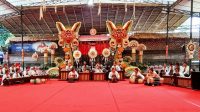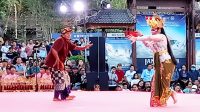WHEN making a visit to Bali and incidentally having a promenade to villages, you will encounter some cattle. Each of which will usually be installed on a cow bell. With the attribute, the breeders can immediately know the existence of their cattle or neighbors are easily identifying the cattle when they escape.
The sound of cow bell can also generate a good music, especially when the cattle are fed. In Bali, there are not ranches with thousands of cattle hoping to make vibrant music with their thousand of bells. However in the past, local farmers or breeders grassed their cattle in the clear rice field after harvest season while waiting for the next planting season. To that end, they closed the irrigation channel into their rice field so the land dried out before the planting season.
Today, such tradition is rarely found because planting season is made three times a year and there is no longer a period to dry out the rice field. Instead, Bali has now some groups of breeder coalesced into Simantri where group members gather their cattle in one place and put them in large cage but cow bell seems so unimportant. It is more focused on ‘commercial’ aspect.
As an agrarian community, many Balinese people had been inspired by this cow bell to make a separate music in the past. They established a group consisting of tens of members with cow bell of larger size than the one used for the cattle. It’s called Okokan. Some regions in Bali have this cow bell music group such as Baturiti (Tabanan) and Tegallalang (Gianyar).
By all means, the large-sized cowbell is embellished with Balinese typical ornament. Supported with other traditional musical instrument, it will generate unique music. This traditional music is virtually presented in every cultural festival on the island, including the annual Bali Arts Festival. In combination with corresponding costumes, it will become a magnificent spectacle worth visiting.










